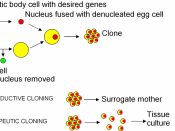We are living in times where we constantly strive for new heights; to create the seemingly impossible, to break records, and to make life easier. It is an undisputed fact that we have evolved in numerous ways as human beings and one can recognize the beneficial changes that advancements in science and technology has brought about in our world today. The efforts of genetic engineers have made a great impact on our world today. In recent years, the development of cloning and genetically modified foods has been a breakthrough in modern science. Cloning and it's technology are necessary and should be continued to continually find cures to diseases, solve the infertility problem and potentially allow more people with extraordinary traits to be born into this worldHigh hopes in developing new cures and treatments for serious and unmet medical needs have been driven by the cloning technology (Milgram & Rantala, 1999, p.
215). Some diseases are inborn and cause permanent defects on an individual. This suffering may end soon if cloning is permitted. Doctors expect to eventually offer expectant mothers an option to diagnose and treat the future early enough to correct disorders such as Down's Syndrome, miscarriages, and genetically induced sensory diseases like blindness or deafness (Chellam, 1999, 1 October). Parents worried about their child being born deformed can be rest assured that cloning is actually genetically safer than normal sexual reproduction because it bypasses the most common form of birth defect having the wrong number of chromosomes (Kolata, 1998, pp. 237 - 238). Through cloning, it is possible to control the number of chromosomes to avoid abnormalities as it starts off with a normal cell that has the proper amount of chromosomes (Kolata, 1998, p. 239). Human cloning would solve the problem of finding a transplant donor whose organ...


